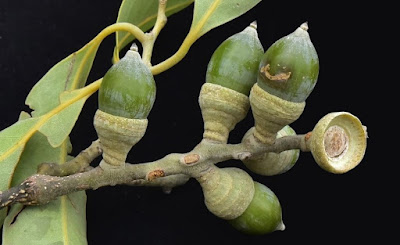 |
| Lithocarpus eiadthongii Sinbumr., Rueangr. & Sungkaew, in Sinbumroong, Rueangruea, Teerawatananon & Sungkaew, 2022. |
Abstract
A new species of the genus Lithocarpus, L. eiadthongii, from southern part of Thailand is described and illustrated. Its colour photographs are also provided and its conservation status is assessed. The new species is superficially similar to L. melataiensis, L. pusillus and L. vuquangensis in terms of leaf and fruit size. Notwithstanding, it differs from the three species in several aspects e.g. leaf apex, leaf blade covering, cupule stalk, cupule size, nut size and nut enclosure.
Keywords: Asia, conservation, diversity, oak, tree, Eudicots
Lithocarpus eiadthongii Sinbumr., Rueangr. & Sungkaew, sp. nov.
Diagnosis:— Lithocarpus eiadthongii is superficially similar to L. melataiensis , L. pusillus and L. vuquangensis. In terms of leaf characters, it may look like L. vuquangensis, but it is, however, much different from the latter in terms of fruit characters (having cupule size of 4−7 mm high by 8−13 mm across; cupule surface with (5)6−9 lamellae; nut size of 0.8−1.5 cm across; nut basal scar of 4−8 mm across in L. eiadthongii vs cupule size of ca 14 mm high by ca 18 mm across; cupule surface with 4−5 lamellae; nut size of 2.1−2.4 cm across; nut basal scar of ca 11 mm across in L. vuquangensis). Whilst, in terms of fruit characters, it may look similar to L. melataiensis and L. pusillus, but L. eiadthongii differs from the latter two in having a stalked cupule of 3−6 mm long (vs sessile cupule in L. melataiensis vs sessile to stalked cupule of 2−3 mm long in L. pusillus. Moreover, in terms of leaf characters, L. eiadthongii is much different from the latter two in having a leaf acumen of 3−10 cm long and leaf undersurface with sparsely white to creamy-white waxy to glabrous (vs leaf acumen of 15−22 mm long and leaf undersurface with densely yellowish brown tomentose, sometimes with simple hairs in L. melataiensis vs leaf acumen of 10−30 mm long and leaf undersurface with densely greyish brown tomentose by adpressed, minute, stellate hairs in L. pusillus) ( Table 1).
Etymology:—The specific epithet eiadthongii is named in honour of a well-known Thai dendrologist, Associate Professor Wichan Eiadthong who specialized in many families of Thai flora including Fagaceae (Eiadthong, 1993) .
Vernacular:— Ko look eiad (Thai - ก่อลูกเอียด), meaning an oak tree with small fruit.
Ecology and distribution:— Currently, it is only known from peninsular Thailand; in Namtok Ngao National Park and Klong Naka Wildlife Sanctuary of Ranong province and Si Phang-Nga National Park of Phang-Nga province. They grow in the co-dominant and intermediate layers of the evergreen forest canopy, particularly along the hillsides, between 60 m and 260 m elevation.
Aroon Sinbumroong, Sukid Rueangruea, Atchara Teerawatananon and Sarawood Sungkaew. 2022. Lithocarpus eiadthongii (Fagaceae), A New Stone Oak Species from southern part of Thailand. Phytotaxa. 541(1); 73-78. DOI: 10.11646/phytotaxa.541.1.7
ก่อลูกเอียด Lithocarpus eiadthongii Sinbumr., Rueangr. & Sungkaew โดยคำระบุชนิด eiadthongii ตั้งชื่อเพื่อเป็นเกียรติแก่ ผศ. ดร.วิชาญ เอียดทอง อดีตอาจารย์ผู้ล่วงลับ ภาควิชาชีววิทยาป่าไม้ คณะวนศาสตร์ มหาวิทยาลัยเกษตรศาสตร์ ผลงานของท่านนับเป็นคุณูปการอันใหญ่หลวงแก่วงการวนศาสตร์ เป็นผู้ประสิทธิ์ประสาทวิชารุกขวิทยาป่าไม้ (Forest Dendrology) ให้แก่นิสิตวนศาสตร์จำนวนมากมายนับไม่ถ้วน ท่านนับเป็นผู้สร้างแรงบันดาลใจไม่มากก็น้อยให้ลูกศิษย์ (รุ่นน้อง) หลายๆท่านให้รักในการศึกษาพรรณไม้ ทั้งในการศึกษาต่อและปฏิบัติงานด้านรุกขวิทยาป่าไม้ พฤกษศาสตร์ป่าไม้ และอนุกรมวิธานพืช ทั้งในระดับมหาวิทยาลัย และหน่วยงานราชการ สืบต่อมาจนถึงปัจจุบัน
news.dnp.go.th/news/14817








